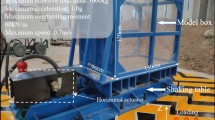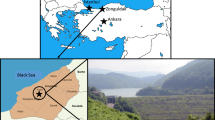Abstract
A new approach referred as “the network modeling method” was developed by the authors to analyze the behaviors of marine structures. In this paper the method is briefly described and applied to predict the loads acting on the connectors between the two modules of the Scientific Research and Demonstration Platform (SRDP), which was deployed in a complicated wave environment near islands and reefs in South China Sea. Based on this method, the response amplitude operators (RAOs) of the connector loads of the SRDP in regular waves, and the time variations of the connector loads of the SRDP in an on-site measured random sea state are predicted and presented. The significant stresses at 20 spots of the local connection structure induced by the connector loads in the sea state are further calculated. The comparisons between the predicted and the on-site measured stresses confirm that the network modeling method is feasible to some extent and especially useful for design of the connectors’ arrangement, estimation of the connector loads and the related structural safety of a multi-module floating structure in early design stage.
Similar content being viewed by others
References
Wang C. M., Tay Z. Y. Very large floating structures: Applications, research and development [J]. Procedia Engineering, 2011, 14: 62–72.
Watanabe E., Wang C. M., Utsunomiya1 T. et al. Very large floating structures: Applications, analysis and design. [EB/OL]. Available: http://www.eng.nus.edu.sg/core/Report200402.pdf.
Rognaas G., Xu J., Lindseth S. et al. Mobile offshore base concepts concrete hull and steel topsides [J]. Marine Structures, 2001, 14(2): 5–23.
Du S. X., Ertekin C. R. Dynamic response analysis of a flexibly joined, multi-module very large floating structure [C]. OCEANS 91 Proceedings, Honolulu, Hawaii, USA, 1991, 1286–1293.
Hamamoto T. Dynamic response of flexible circular floating islands subjected to stochastic waves [C]. Hydroelasticity in Marine Technology: Proceedings of an International Conference, Trondheim, Norway, 1994.
Watanabe E., Utsunomiya T., Wang C. M. et al. Benchmark hydroelastic responses of a circular VLFS under wave action [J]. Engineering Structures, 2006, 28: 423–430.
Price W. G., Wu Y. S. Hydroelasticity of marine structures [C]. Proceedings of the XVIth International Congress of Theoretical and Applied Mechanics, Lyngby, Denmark, 1984, 311–337.
Waals O. J., Bunnik T. H. J., Otto W. J. Model test and numerical analysis for a floating mega island [C]. Proceedings of the 37th International Conference on Ocean, Offshore and Arctic Engineering (OMAE2018), Madrid, Spain, 2018.
Watanabe E., Utsunomiya T., Wang C. M. Hydroelastic analysis of pontoon-type VLFS: A literature survey [J]. Engineering Structures, 2004, 26: 245–256.
Maeda H., Inoue R., Togawa S. et al. On the motions of a floating structure which consists of two or three blocks with rigid or pin joints [J]. Naval Architecture and Ocean Engineering, 1979, 17: 91–98.
Fu S., Moan T., Chen X. J. et al. Hydroelastic analysis of flexible floating interconnected structures [J]. Ocean Engineering, 2007, 34(11–12): 1516–1531.
Gao R. P., Tay Z. Y., Wang C. M. et al. Hydroelastic response of very large floating structure with a flexible line connection [J]. Ocean Engineering, 2011, 38(17–18): 1957–1966.
Kim D., Chen L., Blaszkowski Z. Linear frequency domain hydroelastic analysis for McDermott’s mobile offshore base using WAMIT [C]. Proceedings of the 3rd International Workshop on Very Large Floating Structures, Honolulu, Hawaii, USA, 1999, 105–113.
Ertekin R. C., Riggs H. R., Che X. L. et al. Efficient methods for hydroelastic analysis of very large floating structures [J]. Journal of Ship Research, 1993, 37(1): 58–76.
Wang D., Riggs H. R., Ertekin R. C. Three-dimensional hydroelastic response of a very large floating structure [J]. International Journal of Offshore and Polar Engineering, 1991, 1(4): 307–316.
Riggs H. R., Ertekin R. C., Mills T. R. J. Impact of stiffness on the response of a multimodule mobile offshore base [J]. International Journal of Offshore and Polar Engineering, 1999, 9(2): 126–133.
Riggs H. R., Ertekin R. C., Mills T. R. J. A comparative study of RMFC and FEA models for the wave-induced response of a MOB [J]. Marine Structures, 2000, 13(4–5): 217–232.
Zhao H., Xu D., Zhang H. et al. An optimization method for stiffness configuration of flexible connectors for multi-modular floating systems [J]. Ocean Engineering, 2019, 181: 134–144.
Xu D. L., Zhang H., Lu C. et al. On study of nonlinear network dynamics of flexibly connected multi-module very large floating structures [C]. The 2nd International Conference on Vulnerability and Risk Analysis and Management Liverpool, UK, 2014.
Zhang H. C., Xu D. L., Xia S. Y. et al. Nonlinear network modeling of multi-module floating structures with arbitrary flexible connections [J]. Journal of Fluids and Structures, 2015, 59: 270–284.
Xu D. L., Zhang H. C., Lu C. et al. Analytical criterion for amplitude death in nonautonomous systems with piecewise nonlinear coupling [J]. Physical Review E, Statistical, Nonlinear, and Soft Matter Physics, 2014, 89(4): 042906.
Shi Q. J., Zhang H. C., Xu D. L. et al. Experimental validation of network modeling method on a three-modular floating platform model [J]. Coastal Engineering, 2018, 137: 92–102.
Barabasi A. L., Albert R. Emergence of scaling in random networks [J]. Science, 1999, 286(5439): 509–512.
Seo J., Park W. S., Yi J. H. et al. Viscous damping of wave power extracting system with a resonant channel attached to an existing vertical breakwater [C]. Proceedings of the Twenty-fifth International Ocean and Polar Engineering Conference, Kona, Big Island, Hawaii, USA, 2015, 902–906.
Taghipour R., Moan T. Efficient frequency-domain analysis of dynamic response for the multi-body wave energy converter in multi-directional waves [C]. Proceedings of the Eighteenth (2008) International Offshore and Polar Engineering Conference, Vancouver, Canada, 2008, 357–365.
Wu Y. S., Ding J., Gu X. K. et al. The progress in the verification of key technologies for floating structures near islands and reefs [C]. The 30th International Society of Offshore and Polar Engineering Conference, Shanghai, China, 2020.
Acknowledgements
This work was supported by the Ministry of Industry and Information Technology (Grant No. [2016]22), the Ministry of Science and Technology (Grant No. 2013CB36100).
Author information
Authors and Affiliations
Corresponding author
Additional information
Project supported by the National Natural Science Foundation of China (Grant Nos.11702088, 11902084).
Biography
Rui Ding (1990-), Female, Ph. D. Candidate, E-mail: dingr07@hnu.edu.cn
Rights and permissions
About this article
Cite this article
Ding, R., Yan, Dl., Zhang, Hc. et al. An application of network modeling method to scientific research and demonstration platform—Connector load analysis. J Hydrodyn 33, 33–42 (2021). https://doi.org/10.1007/s42241-021-0011-2
Received:
Revised:
Accepted:
Published:
Issue Date:
DOI: https://doi.org/10.1007/s42241-021-0011-2




